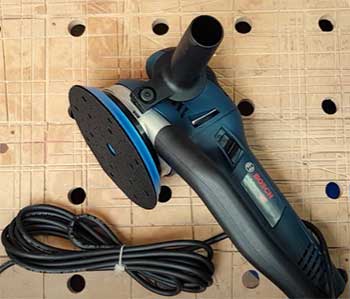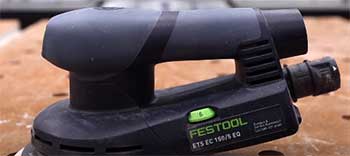Bosch GET75-6N is a dual-mode random orbit sander, meaning it has a standard random-orbit mode and an eccentric-orbit turbo direct drive mode in one machine, whereas Festool has separate machines for these two functions.
This article will show some features and differences between these two products. After reading them, you can make your own decision on which sander will work best for you.
I consulted many professionals and colleagues before writing this piece. Rest assured, you’ll get authentic information here.
A Quick Comparison Table
Here is a quick comparison table between Bosch GET75-6N and Festool random orbital sanders:
| Aspects | Bosch GET75-6N | Festool |
| Product Type | Dual-Mode Random Orbit Sander | Wireless Random Orbit Sander |
| Available Variants | One Available Variant | Three Available Variants |
| Special Feature | Comes With A Dual-Mode Design | Mobile And Powerful |
| Benefits | Offers More Benefits | Offers Fewer Benefits |
| Included Items | A Lot Of Items | A Lot Of Items |
In-Depth Comparisons Between Bosch GET75-6N And Festool Sanders
Now that you’ve drawn some basic ideas about these random orbital sanders, it’s time we dive in for more details. To make the right call, you need more comprehensive information about them.
So, here are some key differences between Bosch GET75-6N and Festool Sanders:
- Nature of Sander/Polisher

Bosch GET75-6N is an ergonomically designed 6 In. orbital sander with dual-mode.
You will get both a standard random-orbit mode sander and a direct-drive, eccentric-orbit turbo mode sander in this machine.
Together, they ensure aggressive stock removal while operating.
Besides, you will get 3 times more removal rate than a standard random-orbit sander.
On the contrary, Festool has two different standard orbit modes and eccentric, direct-drive turbo orbit mode sanding devices. However, it offers excellent mobility and easy movement while working.
This tool will provide powerful performance with a compact design and proper weight distribution.
A cordless Festool sander is mobile, and you can work effortlessly. Besides, it will last longer than most sanders with outstanding build quality.
- Available Variants
You will get only one variant for Bosch GET77-6N random orbit sander. Although, it’s a dual-mode sander. So, you are getting standard orbit and a direct-drive, eccentric-orbit sander altogether.
But for Festool, you will get multiple variants for both types of sanders. Its eccentric cordless sander has 3 variants: a Basic sander, an I-Plus sander, and an I-Set sander. There are differences in various aspects across the variants.
For example, both I-Plus and I-Set sanders come with 2 Ergo-I battery packs, which is not the case for the basic variant.
Again, I-Set has an 18 Volt Ergo mains adapter, but the other two variants don’t. Similarly, a Festool Standard orbit sander also has three variants: Basic, I-Plus, and I-Set. Plus, they come in wireless mode and electric mode.
- Variation of Features
As very high-quality products, both Bosch GET75-6N and Festool have many superior features that make them stand out from others. Let’s see some of those features.
Bosch GET75-6N comes with a dual-mode design. You will get a turbo mode that can remove stock three times quicker than other sanders.
Besides, you will get a multi-hole pad system and versatile hose compatibility for better performance.
In addition, you will get a built-in dust port and an integral pad-dampening system for easy dust removal and clean-up.
On the other hand, Festool wireless sander is mobile and powerful. You can effortlessly remove stock with this superior product.
Because of a powerful battery, you will get unlimited running time without any interruptions. Besides, its compact design makes the sander desirable to many people.
- Different Benefits
You can easily switch between the standard-orbit and turbo direct-drive eccentric-orbit mode for the Bosch GET75-6N sander with a dual-mode design.
Its turbo mode has a direct-drive rotation that provides 3 times more removal speed than other standard sanders.

Besides, you can use this sander machine with various abrasive disks.
Its dusk port is directly connected to a vacuum hose.
You will get an ultra-smooth and consistent stock-removing performance from this sander device.
In contrast, both Festool wireless and electric sanders are convenient and safe. The wireless model works ergonomically and independently because of its cordless design.
You can achieve the expected result quicker than other devices. It is a one-handed sander for a small and narrow surface.
You can easily sand old paints and varnish on many frames and doors quite easily using a Festool sander. On top of that, you will get your work done on the first try with its smooth and effective stock-removing performance.
- Included Items
Both sanding devices come with a lot of items included in the package. All these items are necessary for reliable and better performance.
With a Bosch GET75-6N sander machine, you will get a dual-mode random orbit sander, one medium backing pad, one hex pad wrench, one sanding disc, one removable front handle, and two vacuum hose adapters.
By contrast, a Festool Cordless Eccentric Sander I-Set comes with two Ergo-I battery packs, one rapid charger, one 18 V Ergo main adapter, Festool Protector, a chip collecting bag, one sanding pad, etc.
As you can see, both devices have many items included in their package.
- Dust Collection
Dust collection is one area where Festool distinctly beats Bosch.
The Bosch GET75-6N relies on standard punched holes in third-party sanding discs. A simple rubber nub connects to shop vac hoses. It captures moderate amounts of dust, but a lot still escapes. Changing grits means replacing the paper disc.
The Festool ETS 125 EQ utilizes Festool’s Granat abrasives and a proprietary dust extraction port. This creates superior suction directly through the sanding pad, capturing virtually all airborne dust particles. The Granat discs also have a thicker foam backing that repels swarf.
Festool’s Granat sanding discs and pads are long-lasting and can be quickly cleaned for grit changes instead of replaced.
So for dust collection, the Festool system clearly beats the Bosch.
- Price
There’s no contest when it comes to price: Bosch offers tremendous value.
The Bosch GET75-6N costs around $150. That’s an incredible price for such a powerful, ergonomic sander.
Meanwhile, the Festool ETS 125 EQ retails for $540. That’s over 3X more!
You’re certainly paying a premium for Festool’s dust collection capabilities and branding. While the Festool may be worth it for some, the Bosch gives you close to equivalent performance at a fraction of the cost.
Which Sander Is Best For You?

Based on our in-depth comparison, here are the main pros and cons of Bosch and Festool sanders:
Reasons to Choose Bosch
- Lower price – Bosch sanders offer far better value for money. You get excellent performance at a very wallet-friendly price point.
- Comfortable ergonomics – Thoughtful design makes Bosch sanders among the most comfortable and easy to grip for extended use.
- Great for finishing – Bosch random orbital models have all the power you need for smooth, swirl-free fine sanding.
- User-friendly operation – Simple controls, soft start, and familiar sandpaper make Bosch sanders easy to get up and running.
Reasons to Choose Festool
- Superior dust collection – Festool’s fully integrated dust extraction system captures virtually all dust when used with a CT extractor.
- Innovative features – From rapid pad changes to anti-static pads, Festool sanders are packed with clever design details.
- Cohesive system – Festool abrasives, accessories, and tools are made to work seamlessly together.
- Better for coarse sanding – Models like the ROTEX 150 can handle the toughest sanding jobs where Bosch orbital-only sanders struggle.
- Precise engineering – Festool’s German-made sanders deliver incredible performance and longevity that justifies the price for professionals.
So in summary:
Bosch sanders provide excellent value for finish work while Festool excels at advanced dust collection and coarse sanding capability.
If budget is a factor, Bosch is hard to beat. For professional workshops invested in the Festool ecosystem, the premium German sanders are worth the investment.
Both brands make fantastic sanders though – you really can’t go wrong!
Final Thoughts
The right sander machine can make your task easy, plus you can save many times with it. So, you must choose the right one available to you. After reading my comparison between Bosch GET75-6N and Festool, I’m sure you have found the right sander.
I’ve shown you the features and differences between these two sanders. Now you have a complete picture in front of you. So, it’s time for you to do the right thing—best of luck.
